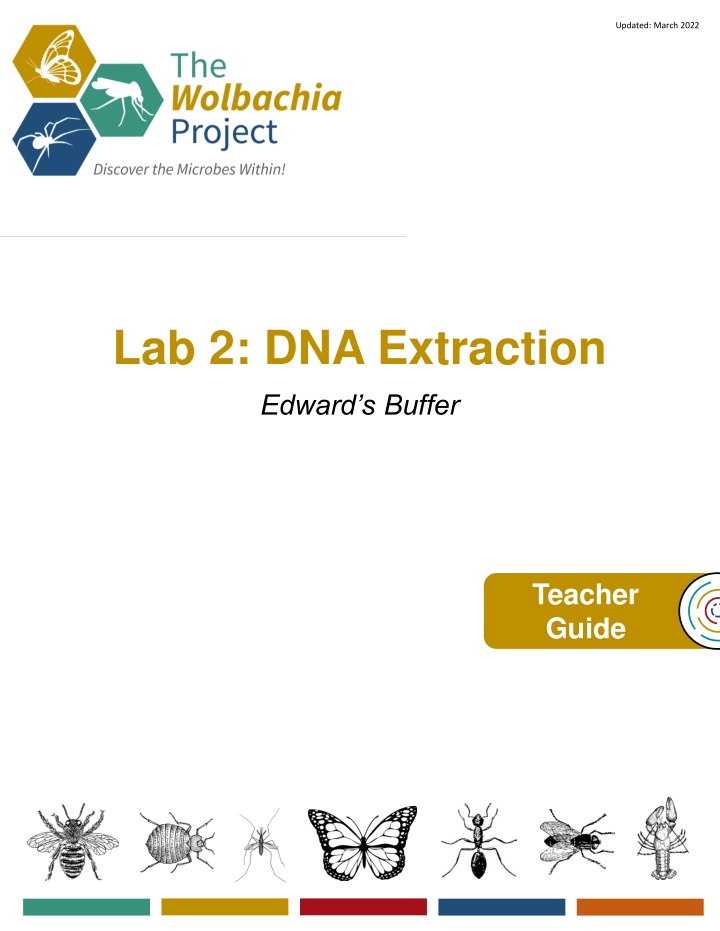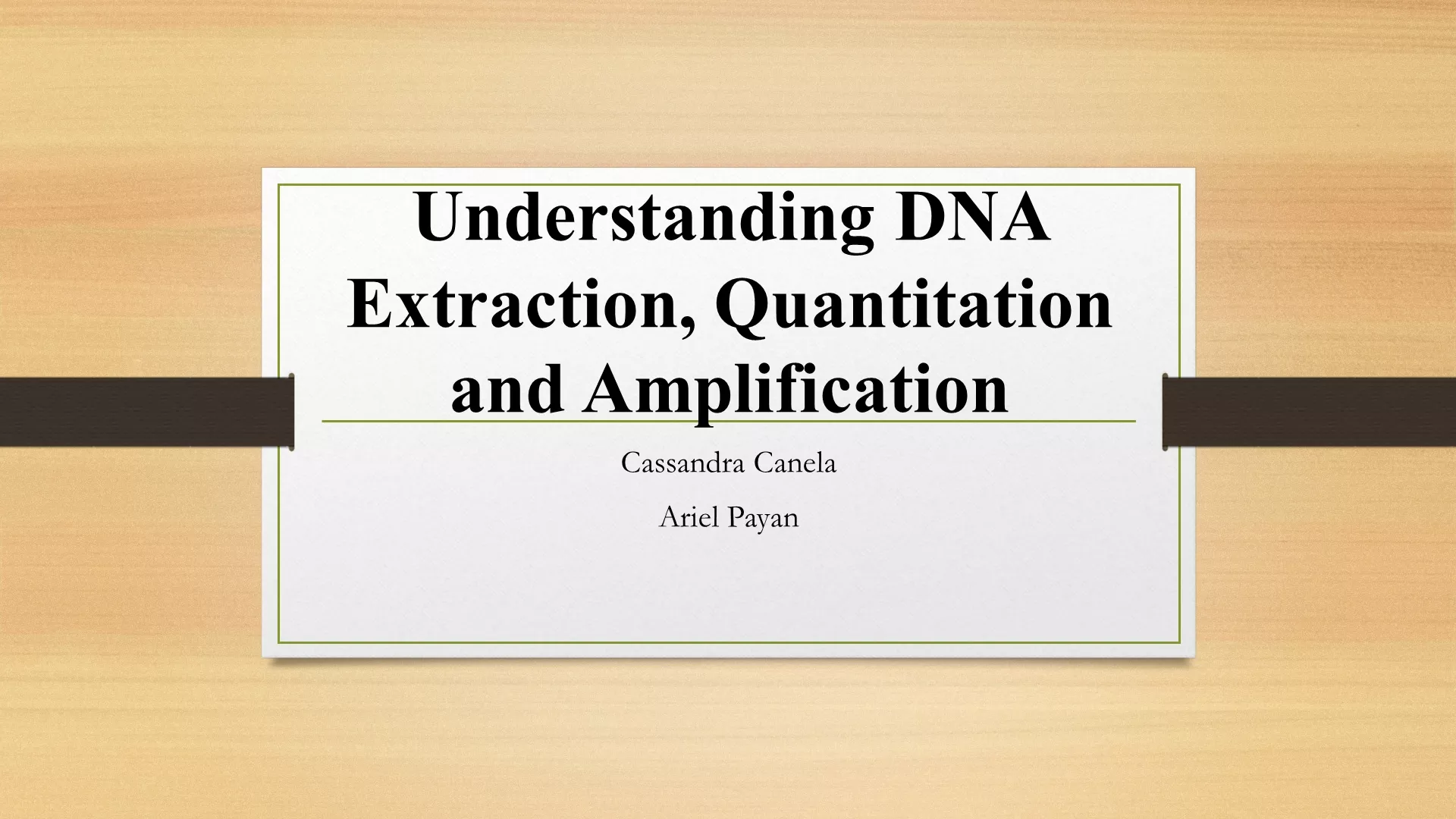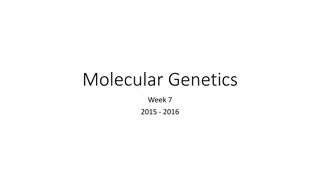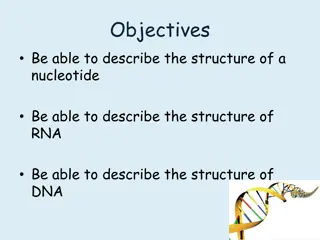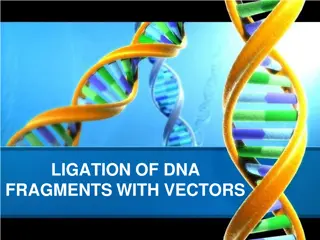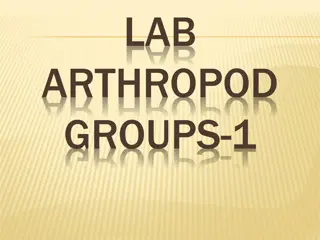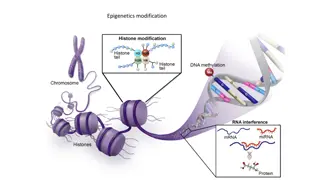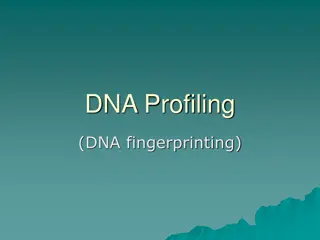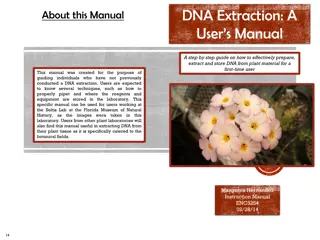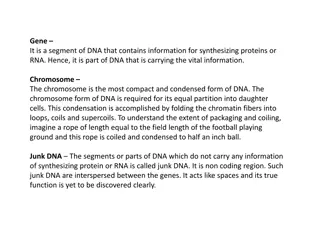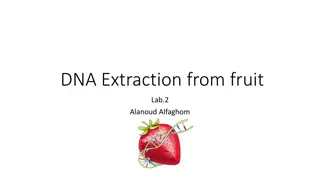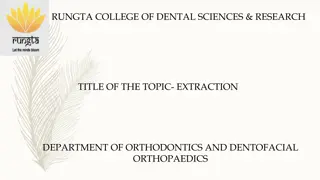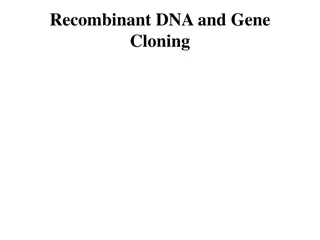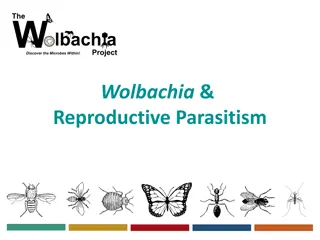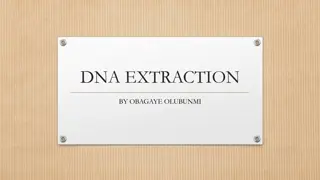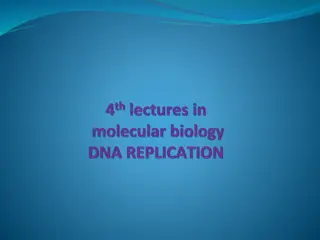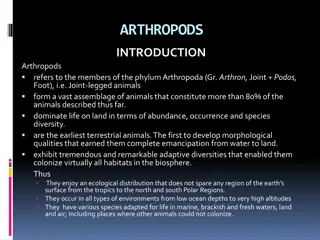Lab 2: DNA Extraction Techniques for Arthropods and Wolbachia
In this lab activity, students will learn how to isolate genomic DNA from arthropods and Wolbachia bacteria. The goal is to transition from fieldwork to molecular biology, utilizing DNA as a diagnostic tool. The activity involves extracting total genomic DNA from identified species and includes pre-lab questions on DNA structure, controls in the experiment, and rotor balancing. The Wolbachia Project aims to increase biotechnology skills and foster inquiry-based research practices.
Download Presentation

Please find below an Image/Link to download the presentation.
The content on the website is provided AS IS for your information and personal use only. It may not be sold, licensed, or shared on other websites without obtaining consent from the author.If you encounter any issues during the download, it is possible that the publisher has removed the file from their server.
You are allowed to download the files provided on this website for personal or commercial use, subject to the condition that they are used lawfully. All files are the property of their respective owners.
The content on the website is provided AS IS for your information and personal use only. It may not be sold, licensed, or shared on other websites without obtaining consent from the author.
E N D
Presentation Transcript
Updated: March 2022 Lab 2: DNA Extraction Edward s Buffer Teacher Guide
The Wolbachia Project 1 Arthropod Identification DNA Extraction 2 PCR 3 Gel Electrophoresis 4 Bioinformatics 5 Content is made available under the Creative Commons Attribution-NonCommercial-No Derivatives International License. Contact (info@wolbachiaproject.org) if you would like to make adaptations for distribution beyond the classroom. The Wolbachia Project: Discover the Microbes Within! was developed by a collaboration of scientists, educators, and outreach specialists. It is directed by the Bordenstein Lab. https://www.wolbachiaproject.org LAB 2: DNA EXTRACTION 2
Activity at a Glance Goal Students are introduced to DNA extraction techniques. They will isolate genomic DNA from arthropods and Wolbachia, the endosymbiotic bacteria that live within the cells of about 40% of arthropod species. Learning Objectives Upon completion of this activity, students will transition from fieldwork and morphological classification (Lab 1) to molecular biology and biotechnology; learn about DNA as a diagnostic tool to discover the unseen microbes; increase abilities in biotechnology; and understand the process of inquiry and discovery-based research. They will isolate total genomic DNA from species identified in the Insect Identification Lab. Prerequisite Skills Prior practice with micropipettes. Assessed Outcomes Assess the student s knowledge of insects infected with Wolbachia. They should understand that both Wolbachia DNA and arthropod (specifically mitochondrial) DNA will be extracted from infected hosts. Assess understanding of the positive and negative control insects. Assess ability to complete the DNA extraction. Assess organizational skills during this lab. Teaching Time 1-2 class periods: If students are extracting DNA from small, whole insects (i.e., fruit flies), the lab activity may be completed in one class period. However, dissecting larger arthropods will likely require two class periods. If breaking into two class periods, there is an optional stopping point after Step 13. DNA is stable when precipitated in isopropanol. LAB 2: DNA EXTRACTION 3
Pre-Lab Questions: Answer Sheet Read through the entire protocol and answer the questions below. 1. Based on your knowledge of DNA structure, what is the complementary strand of this DNA sequence? 5 ATG CCG GAA TCG TTA GCA 3 3 TAC GGC CTT AGC AAT CGT 5' 2. Is it possible for your DNA extraction to contain only Wolbachia DNA? Explain why or why not. No. Based on this extraction method, all cellular DNA will be collected. This includes nuclear, mitochondrial, Wolbachia, and phage WO DNA. DNA may also be isolated from other bacteria, eukaryotic viruses, and mobile DNA. In order to obtain only Wolbachia DNA, it would be necessary to first purify Wolbachia away from insect cells. 3. List the two controls used in this experiment. If we already have control DNA for PCR, why do we need controls at this stage? (i) Wolbachia-infected Drosophila and (ii) uninfected Drosophila. Including controls at this step allows for the measurement of success and accuracy of the overall DNA extraction. The lack of Wolbachia amplification in a (+) control indicates ineffective DNA extraction. On the other hand, the amplification of Wolbachia DNA in the (-) control indicates contamination during the DNA extraction. If results for the controls are not accurate, use caution when interpreting results for experimental samples. 4. Which centrifuge rotor(s) is properly balanced? 1 1 1 8 8 2 2 8 2 7 7 3 3 7 3 6 4 6 4 6 4 5 5 5 C A B 5. How would you properly balance the other rotor(s)? In both A and C, fill one labeled tube with water and use it as a balancer. Rotor A can be balanced with a tube in #4 and Rotor C can be balanced with a tube in #6. 6. What would happen if you used the same pipet tip throughout the entire protocol? Every sample would be contaminated with DNA from the previous samples. In addition, the reagents would all be contaminated. Therefore, it is highly recommended to do the (-) control last in order to detect contamination. LAB 2: DNA EXTRACTION 4
Pre-Lab Preparation Prior to lab: Obtain +/- Drosophila controls Prepare buffers Cell Lysis Buffer DNA Elution Buffer Aliquot 1 ml of each reagent per group* Edwards buffer Isopropanol 70% ethanol TE buffer Review Student Guide and Pre-Lab Questions with class. Day of lab: Place isopropanol in freezer Turn on water bath or heating block (95 C) immediately prior to lab. Water can begin boiling on a hotplate while students are preparing and grinding the sample. Cell Lysis DNA Elution Edwards Buffer Tris/EDTA (TE) Buffer To make 50 ml: To make 100 ml: 2.5 ml of 0.5 M EDTA 2.5 ml of 10% SDS 2.5 ml of 5 M NaCl 10 ml of 1 M Tris, pH 8.0 32.5 ml of distilled water 200 ul of 0.5 M EDTA 1 ml of 1 M Tris, pH 8.0 99 ml of distilled water Store at room temperature. Store at room temperature. * The recommended aliquots assume that each group will extract DNA from two experimental arthropods, a negative control, and a positive control. Alternatively, the class can share a 50 ml tube of each solution. This is generally discouraged because sharing reagents increases the likelihood of contamination and will create a resource bottleneck (for time management). Refer to the Recipe Cards on page 6. Alternatively, you may buy sterile, pre-mixed solutions of 0.5 M EDTA, 10% SDS, 5 M NaCl, and 1 M Tris. This will eliminate the need for autoclave sterilization. LAB 2: DNA EXTRACTION 5
Stock Solution Recipe Cards Each recipe makes 100 ml and can be stored at room temperature. 0.5 M EDTA (pH 8.0) 10% SDS 18.61 g EDTA 80 ml distilled water NaOH (solution or solid) 10 g SDS 80 ml distilled water Dissolve 10 g SDS in 80 ml distilled water Use a magnetic stirrer to mix the solution Bring the volume to 100 ml with distilled water Aliquot as needed Add 18.61 g EDTA to 80 ml distilled water Use a magnetic stirrer to mix the solution Adjust the pH to 8.0 (with NaOH) to dissolve Bring volume to 100 ml with distilled water Aliquot as needed and sterilize by autoclaving Wear a face mask to avoid inhalation of SDS dust particles. Do not autoclave SDS. EDTA will not dissolve until the pH is adjusted to 8.0. 5 M NaCl 1 M Tris (pH 8.0) 29.2 g NaCl 80 ml distilled water 12.1 g Tris Base (or Trizma) 70 ml distilled water concentrated HCl Dissolve 29.2 g NaCl in 80 ml distilled water Use a magnetic stirrer to mix the solution Bring the volume to 100 ml with distilled water Aliquot as needed and sterilize by autoclaving Dissolve 12.1 g Tris in 70 ml distilled water Use a magnetic stirrer to mix the solution Adjust the pH to 8.0 with concentrated HCl Aliquot as needed and sterilize by autoclaving 5M NaCl is tricky to dissolve; it may need to stir overnight. Edwards Buffer (Cell Lysis) TE Buffer (DNA Elution) 5 ml of 0.5 M EDTA 5 ml of 5 M NaCl 20 ml of 1 M Tris, pH 8.0 65 ml of distilled water 5 ml of 10% SDS 200 ul of 0.5 M EDTA 1 ml of 1 M Tris, pH 8.0 99 ml of distilled water Mix all of the above Aliquot as needed and sterilize by autoclaving If all reagents are sterile: Mix all of the above Aliquot as needed If reagents are not sterile: Mix EDTA, NaCl, Tris, and water Sterilize by autoclaving Add SDS Aliquot as needed You may purchase EDTA, SDS, NaCl, and Tris as pre- mixed, sterile solutions that are adjusted to desired pH and concentration. Simply mix them together to make the two buffers. This will eliminate the need for a pH meter and autoclave. LAB 2: DNA EXTRACTION 6
DNA Extraction: Annotated Protocol Class Materials Water bath, 95 C Vortexer (optional) Mini-centrifuge (10,000 x g) Float rack Metal tongs Ice bucket or cooler Materials per Group 2 Arthropod specimens +/- Drosophila controls Distilled water Gloves Kimwipes (or paper towels) Petri dish Dissecting tools (tweezers/scalpel) Cell lysis buffer DNA elution buffer Isopropanol, cold 70% Ethanol 1.5 ml microcentrifuge tubes Tube rack Sterile pestles Pipette (20-200) Pipette tips Waste cup for tips Waste cup for liquids Sharpie Paper towels Parafilm Sample Preparation 1. Use tweezers to carefully transfer the arthropod to a Petri dish. You may substitute the Petri dish with a shallow container or sheet of wax paper. 2. Rinse with water using either a squirt bottle or a 20-200 ul pipette. DNA precipitates in the presence of alcohol. Therefore, remove as much preservative as possible prior to beginning the extraction. 3. Blot dry excess liquid. You can use Kimwipes or absorbent paper towels. 4. Remove the abdomen of the insect and cut off a small piece (roughly ~2 mm, or small enough to fit in the bottom of a microcentrifuge tube). If the specimen is smaller than a grain of rice, use the entire body. If the arthropod is much larger than a fruit fly or small ant, dissect out the reproductive tissues. Use the illustration (Figure 2.3) in the Student Guide to inform the dissection or have students research the anatomy of each particular arthropod prior to this lab. 5. Place the specimen in a labeled 1.5ml microfuge tube. Samples should be small enough to fit in the bottom of the tube. Cell Lysis 6. Add 100 ul Cell Lysis Buffer to the first tube. Always change pipet tips between each sample. NEVER place a used tip in the reagent bottle as this will contaminate every sample going forward. 7. Use a sterile pestle to grind the sample for 1 minute. Always change pestles between samples. If you do not have enough pestles for each arthropod, clean the pestle between samples by dipping in a small vial of 10% bleach followed by 70% ethanol. Ensure that particles have been removed from pestle. Pestles designed specifically for 1.5 ml tubes are highly recommended and will yield best results. However, you can also make homemade pestles by heating the end of a pipet tip over a Bunsen burner to create a rounded pestle-like tip. 8. Add an additional 100ul of Cell Lysis Buffer. Grind a few more times, then dip the pestle in the arthropod lysate to rinse and remove remaining debris. Change pestle and pipet tip; move on to the next sample and repeat Steps 6-8. If the sample is not fully submerged in Cell Lysis Buffer at this point, add a little more. This protocol was adapted and modified for The Wolbachia Project; it is made available under CC-BY-NC-ND. LAB 2: DNA EXTRACTION 7
DNA Extraction: Annotated Protocol . Cell Lysis (continued from previous page) 9. Heat samples @ 95 C for 5 minutes. You may also use a hot water bath, heat block, or boil water in a microwave. If using a hot plate, Wrap the caps with Parafilm to prevent lids from popping off while heating. Place each of the tubes into a foam rack and place the rack directly in the beaker of hot water. Use tongs or a long metal rod to remove the rack from the hot water. Time saving tip: While samples are incubating, label new tubes containing 150 ul cold isopropanol in preparation for the DNA precipitation step. To reduce class time, you may also prepare isopropanol aliquots prior to the lab. Make sure that students label the new tubes before transferring supernatant. Unlabeled tubes lead to mixed up samples. Cellular Debris Removal 10. Place tubes in ice bucket or refrigerator to cool to room temperature. 11. Vortex tubes for 20 seconds. If you do not have a vortexer, mix tubes by tilting back and forth ~ 50 times. This can be done with the microcentrifuge tubes still in the foam carrier (or in a tube rack) by placing one hand on the top and one on the bottom and gently inverting. 12. Centrifuge for 2 minutes to pellet debris. This protocol was designed for 10,000 x g. However, most units are sufficient in default mode (typically 8,000-10,000 x g). Note that RCF and RPM are not the same. You may convert RPM to RCF using online calculators. - RCF (Relative centrifugal force) refers to force x gravity, or g-force. - RPM (Revolutions per minute) is based on x g and size of the rotor. Always keep the centrifuge balanced! Space samples evenly across the rotor. If unable to properly balance the rotor, fill a labeled tube with water and use it as a balancer. DNA Precipitation & Purification 13. Use a pipet to carefully transfer 150 ul of supernatant to a new tube containing an equal amount (150 ul) of cold isopropanol. This is an optional STOPPING POINT. Store DNA in freezer (-20 C) until next class period. 14. Gently mix samples by inverting approximately 50 times. Mix all tubes at once by placing in a foam carrier or tube rack. Place one hand across the top of the tubes to hold in place while inverting. 15. Centrifuge for 5 minutes to pellet genomic DNA. To easily locate the pellet, orient the hinge of the tube to point away from the middle of the centrifuge. The DNA pellet may be seen near the bottom of the tube under the hinge. 16. Carefully pour the supernatants into a waste cup and invert tubes on a paper towel to air dry for 1 minute. Be careful not to reinvert the tubes prior to placing them on the paper towel as this could cause ethanol to flow back against, and possibly dislodge, the pellets. Pellet may be loose so watch carefully and pour slowly. If the pellet begins to move, add more isopropanol and re-spin. This protocol was adapted and modified for The Wolbachia Project; it is made available under CC-BY-NC-ND. LAB 2: DNA EXTRACTION 8
DNA Extraction: Annotated Protocol DNA Precipitation & Purification (continued from previous page) 17. Add 100 ul of 70% ethanol to each pellet. Ethanol removes excess salts, which is recommended for downstream applications, and shortens the time needed to air dry the pellet. 18. Invert tubes 10 times to wash the DNA. 19. Centrifuge at high speed for 1 minute. 20. Carefully pour off supernatant and invert tubes on a clean paper towel to air dry for about 10 minutes. The pellet may be loose so watch carefully and pour slowly. If the pellet begins to dislodge, add more ethanol and re-spin. Ethanol will interfere with PCR so be sure to air dry as much as possible. DNA Elution 21. Add 50ul of TE Buffer to each tube. TE is recommended here because it solubilizes DNA more quickly than water and protects against nucleases and multiple freeze-thaw cycles. It is possible to move straight to PCR after this step. However, allowing the sample to rehydrate will often yield better results. 22. Recommended: Re-hydrate DNA by incubating samples at 65 C for up to 1 hour or overnight at room temperature. If there is still a tight pellet at bottom of tube, vortex or use pipette tip to dislodge. Mix into solution before moving on to PCR step. Storage 22. Store at 4 C for a few weeks or -20 C indefinitely. Helpful Tips The DNA pellet may not be visible by step 16 that is OK. Continue with the procedure and the pellet will become more visible by step 20. It should appear as a small white dot under the hinge of the microcentrifuge tube. You may have to hold the tube up to the light in order to see the pellet. To ensure optimal results: 1. Grind, grind, grind! 2. Avoid contamination by changing tips between each reagent, sample. 3. Keep the rotor balanced. Teacher Tips If short on time, the ethanol wash may be eliminated by removing steps 16-19. The DNA may contain additional salts, but should be okay for basic PCR reactions. This protocol was adapted and modified for The Wolbachia Project; it is made available under CC-BY-NC-ND. LAB 2: DNA EXTRACTION 9
DNA Extraction: Bench Protocol Sample Preparation 1. Use tweezers to carefully transfer the arthropod to a Petri dish. 2. Rinse with water. 3. Blot dry excess liquid. 4. Remove the abdomen of the insect and cut off a small piece (roughly ~2 mm, or small enough to fit in the bottom of a microcentrifuge tube). If the specimen is smaller than a grain of rice, use the entire body. 5. Place the specimen in a labeled 1.5ml microfuge tube. Cell Lysis 6. Add 100 ul Cell Lysis Buffer to the first tube. 7. Use a sterile pestle to grind the sample for 1 minute. 8. Add an additional 100ul of Cell Lysis Buffer. Grind a few more times, then dip the pestle in the arthropod lysate to rinse and remove remaining debris. Change pestle and pipet tip; move on to the next sample and repeat Steps 6-8. 9. Heat samples @ 95 C for 5 minutes. Cellular Debris Removal 10. Place tubes in ice bucket or refrigerator to cool to room temperature. 11. Vortex tubes for 20 seconds. 12. Centrifuge for 2 minutes to pellet debris. DNA Precipitation & Purification 13. Use a pipet to carefully transfer 150 ul of supernatant to a new tube containing an equal amount (150 ul) of cold isopropanol. 14. Gently mix samples by inverting approximately 50 times. 15. Centrifuge for 5 minutes to pellet genomic DNA. 16. Carefully pour supernatant into waste cup and invert tubes on paper towel to air dry for 1 minute. 17. Add 100 ul of 70% ethanol to each pellet. 18. Invert tubes 10 times to wash the DNA. 19. Centrifuge at high speed for 1 minute. 20. Carefully pour off supernatant and invert tubes on a clean paper towel to air dry for about 10 minutes. DNA Elution 21. Add 50ul of TE Buffer to each tube. Storage 22. Store at 4 C for a few weeks or -20 C indefinitely. This protocol was adapted and modified for The Wolbachia Project; it is made available under CC-BY-NC-ND. LAB 2: DNA EXTRACTION 10
Post-Lab Questions: Answer Sheet 1. Illustrate the contents of each tube upon completion of the following steps. Below, label where the DNA is located. Buffer with DNA Isopropanol Lysis buffer with ground arthropod in solution DNA in TE buffer Arthropod Cellular debris DNA Sample Preparation DNA DNA Elution Cell Lysis Cellular Debris Removal Precipitation In the In the solution In the arthropod In the solution In the pellet supernatant 2. After completion of the DNA precipitation stage, describe the visual appearance of the DNA. Answers will vary and may include solid, white, small dot, invisible to naked eye, etc. 3. Where is Wolbachia located within an arthropod? Why? Wolbachia is located within reproductive tissues because it is vertically transmitted from mother to offspring. Therefore, it must be present in the ovaries to be passed on to the next generation. 4. What is the purpose of isolating the DNA? What is your next step in determining the frequency of Wolbachia? DNA must be isolated to serve as a template in the PCR reaction. The next step will be DNA amplification (PCR) followed by DNA visualization (gel electrophoresis). 5. Imagine that there is an E. coli outbreak in your state and you would like to test the lettuce from your local grocery store. How could you modify this protocol in order to extract DNA from the lettuce (to identify the species) and check for presence/absence of E. coli. ? Keep in mind that (i) E. coli is free-living and not an endosymbiont, and (ii) plant cells are encased in both a cell membrane and cell wall. Answers will vary. The two most important modifications would be to adjust the Sample Preparation and Cell Lysis steps. Because E. coli is free-living, the lettuce should not be washed or preserved in alcohol. This would wash away the E. coli. Because plant cells have a cell wall, modifications to the cell lysis step could include: adding a cellulase (to break down cellulose), using a stronger lysis buffer, using a more efficient mortar and pestle, incubating for a longer period to allow for more efficient lysis, etc. Changes to the DNA Precipitation and DNA Elution steps would not be necessary. LAB 2: DNA EXTRACTION 11
